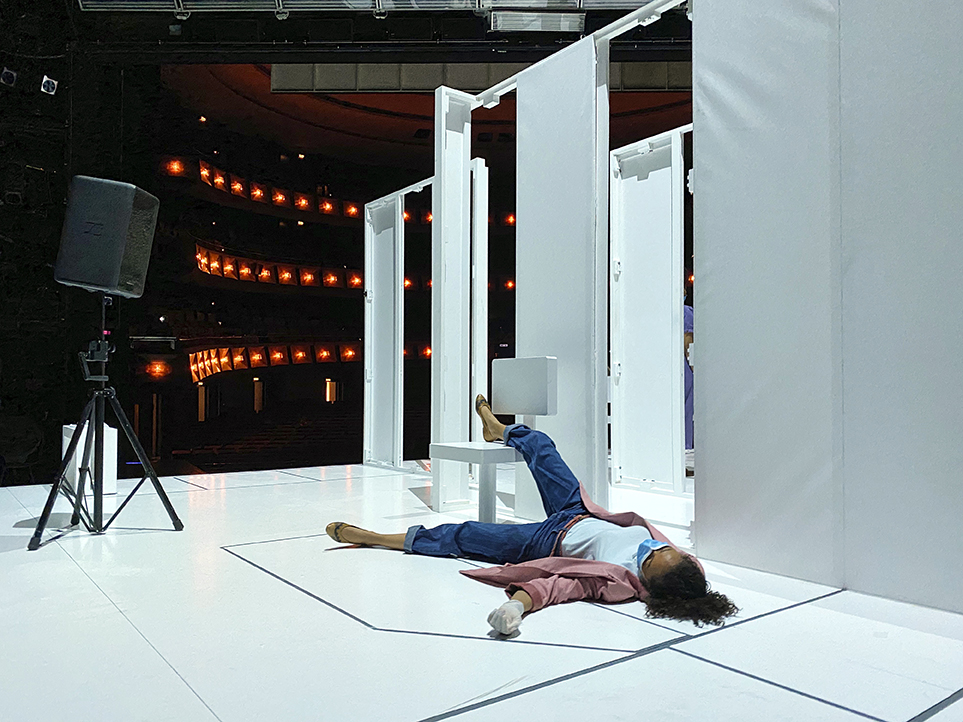 What will a museum guard answer when his or her partner asks at dinner: “How was your day?”
What will a museum guard answer when his or her partner asks at dinner: “How was your day?”
“Well, I had to warn some visitors not to get to close to the art, had to tell a lady not to wear a handbag on her shoulder as she could damage the art and tell a lot of visitors not to take pictures of the art”.
The job seems to be monotonous, as museum guards have to be quiet during the day and their behaviour has to be inconspicuous. This month it’s not ‘same old, same old’ for the guards of the Stedelijk Museum as they feature in Tino Sehgal’s new ‘constructed situation’.
When you enter the room which displays works by Felix Gonzalez-Torres, Marcel Duchamp and Jeff Koons a guard ‘welcomes’ each visitor by hopping from one foot to the other and waves his arms in circles – transforming to a human windmill. After this action he stands still and says: “Tino Sehgal, This Is Good, 2001, collection Museum Ludwig, Cologne”.
At the opening of the performance, Sehgal was present and peeked around the corner of the adjacent room. The first guard performed the action a bit ill at ease and the artist requested that he would look each new visitor into the eyes.
Some visitors felt intimidated by the guard’s action and walked away thinking there is a mad man in the room whereas others shriek with laughter. Is this serious art or is it a prank? Or can it both?
It is a well-considered curatorial decision to present Sehgal’s ‘joker’ guard next to works by ‘colourful’ artists such as Duchamp and Koons. On his right the guard faces Duchamp’s ‘La-boîte-en-valise’ (The artist’s mini museum in a carrying case consisting of 69 miniature replicas and reproductions of his work – including a mini version of the infamous urinal), and in front of him he faces Koons’s ‘Ushering in Banality’ a sculpture of three figures pushing a pig.
The curators also showcase two ends of the spectrum in one room. Sehgal’s immaterial art is standing next to Koons, an artist whose work ‘Balloon Dog (Orange)’ is the epitome of material art. It is the current world record for a single artwork by a living artist ever sold at an auction ($58.4 million).
Sehgal doesn’t create a physical object, a painting or a sculpture, as he is interested to create something that is ephemeral and lasting at the same time. The work should live on in the memory of the public or through word of mouth.
 Not only the guards of the museum but also the ticket controllers are performing one of Sehgal’s work. When I showed my ticket to a ticket controller she exclaimed to me: “Police arm your officers with a taser, ‘This Is New’, a work by Tino Sehgal, 2003”. Every day the museum buys a selection of Dutch and English newspapers from which the ticket controllers can quote a headline. I was amused to see the surprised and confused reactions of the visitors behind me, looking like someone told them they were wearing two different socks.
Not only the guards of the museum but also the ticket controllers are performing one of Sehgal’s work. When I showed my ticket to a ticket controller she exclaimed to me: “Police arm your officers with a taser, ‘This Is New’, a work by Tino Sehgal, 2003”. Every day the museum buys a selection of Dutch and English newspapers from which the ticket controllers can quote a headline. I was amused to see the surprised and confused reactions of the visitors behind me, looking like someone told them they were wearing two different socks.
Pioneering museum directors of the twentieth century, Alexander Dorner (Hannover Museum) and Pontus Hultén (Moderna Museet in Stockholm and Georges Pompidou in Paris) were enthusiastic explorers of the potential of the museum and were advocating new experimental ways of display. In their view a museum should not only be a place to display objects such as paintings and sculptures but a dynamic, interactive environment which hosts and organises film screenings, concerts, dance performances, symposiums, debates, master classes etc.
By hosting the Sehgal exhibition, the Stedelijk Museum can become a place that Dorner and Hultén envisioned for a museum to be. The ‘live encounters’ between the museum staff and the visitors transforms the museum into a vibrant place with unexpected and unpredictable art. Everyone who visits the museum this month has something to share at the dining table that night.
Written by Thierry Somers
Headline in De Volkskrant, 5 February 2015










